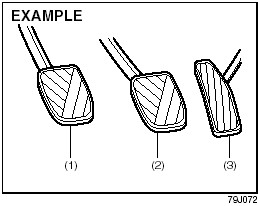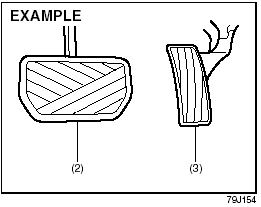Pedals

Manual transaxle

Automatic transaxle
Clutch Pedal (1)
(For manual transaxle).
The clutch pedal is used to disengage the drive to the wheels when starting the engine, stopping or shifting the gearshift lever. Depressing the pedal disengages the clutch.
CAUTION:
Do not drive with your foot resting on
the clutch pedal. It could result in
excessive clutch wear or clutch damage.
Brake Pedal (2)
Your SUZUKI vehicle is equipped with either front and rear disc brakes or front disc brakes and rear drum brakes.
Depressing the brake pedal applies both sets of brakes.
You may hear occasional brake squeal when you apply the brakes. This is a normal condition caused by environmental factors such as cold, wet, snow, etc.

WARNING:
If brake squeal is excessive and
occurs each time the brakes are
applied, you should have the brakes
checked by your SUZUKI dealer.

WARNING:
Do not “ride” the brakes by applying
them continuously or resting your
foot on the pedal. This will result in
overheating of the brakes which
could cause unpredictable braking
action, longer stopping distances or
permanent brake damage.
Accelerator Pedal (3)
This pedal controls the speed of the engine. Depressing the accelerator pedal increases power output and speed.
See also:
Using the 2WD/i-AWD (intelligent All Wheel Drive) Switch (if equipped)
Using the 2WD/i-AWD (intelligent All Wheel Drive) Switch (if equipped)
This i-AWD system enables you to select
the driving mode according to the driving
conditions by operating the 2WD/i-AWD
swi ...
2010 Suzuki Kizashi review 2
An all-new model, the 2010 Suzuki Kizashi (ke-ZAH-shee) is a midsize car the
manufacturer characterizes as a sport sedan. Four years have passed since Suzuki
discontinued its previous midsize seda ...
Ride & Handling
The Grand Vitara has independent front and rear suspensions, which remains
the exception among offroad vehicles, but I didn't find the ride particularly
carlike. The firmness is more like a conven ...
